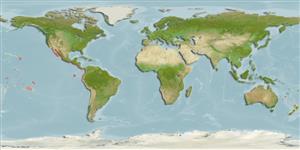Common names from other countries
Teleostei (teleosts) >
Gobiiformes (Gobies) >
Gobiidae (Gobies) > Gobiinae
Etymology: Bathygobius: Greek, bathys = deep + Latin, gobius = gudgeon (Ref. 45335).
More on author: Ginsburg.
Environment: milieu / climate zone / depth range / distribution range
Ecology
Marine; reef-associated. Tropical
Eastern Pacific: Bahía Magdalena and the Gulf of California in Mexico to northern Peru.
Size / Weight / Age
Maturity: Lm ? range ? - ? cm
Max length : 20.0 cm TL male/unsexed; (Ref. 55763); 9.5 cm TL (female); common length : 12.0 cm TL male/unsexed; (Ref. 55763)
Body small; tip of tongue bifurcated; two dorsal fins, the first with 7 flexible spines; scales large and readily visible; tips of uppermost 3 to 5 pectoral rays free; body olive green to brown; flanks with dark spots and/or diffuse (Ref. 55763); pectoral free rays, typically the first and invariably the remaining four, branched at least twice; first dorsal fin distinctly pigmented to distal edge; postorbital dark blotches on oculoscapular groove large, elongate medially; pelvic disc more or less rounded, with large lateral lobes, sometimes attenuate, and disc length about two-thirds to four-fifths abdomen; pectoral rays 19-20 (18-21); scales in lateral series 34-36 (32-38) (Ref. 87607).
Inhabits high, sandy-bottom tide pools along rocky coasts (Ref. 5592). Maximum length for female (Ref. 87607).
Life cycle and mating behavior
Maturities | Reproduction | Spawnings | Egg(s) | Fecundities | Larvae
Thomson, D.A., 1987. Reef fishes of the Sea of Cortez. The rocky-shore fishes of the Gulf of California. The University of Arizona Press, Tucson. 302 p. (Ref. 5592)
IUCN Red List Status (Ref. 130435)
CITES (Ref. 128078)
Not Evaluated
Threat to humans
Harmless
Human uses
Fisheries: commercial; aquarium: commercial
Tools
Special reports
Download XML
Internet sources
Estimates based on models
Preferred temperature (Ref.
115969): 19.5 - 28.9, mean 25.1 (based on 320 cells).
Phylogenetic diversity index (Ref.
82804): PD
50 = 0.5000 [Uniqueness, from 0.5 = low to 2.0 = high].
Bayesian length-weight: a=0.00708 (0.00333 - 0.01504), b=3.09 (2.92 - 3.26), in cm Total Length, based on LWR estimates for this (Sub)family-body shape (Ref.
93245).
Trophic level (Ref.
69278): 3.7 ±0.6 se; based on size and trophs of closest relatives
Resilience (Ref.
120179): Medium, minimum population doubling time 1.4 - 4.4 years (Preliminary K or Fecundity.).
Fishing Vulnerability (Ref.
59153): Low vulnerability (10 of 100).
